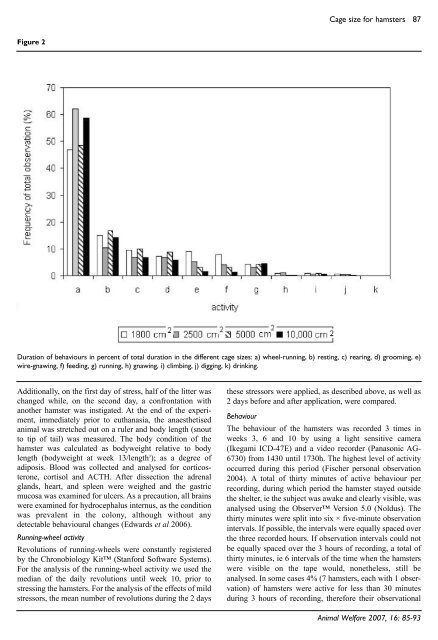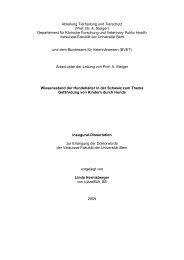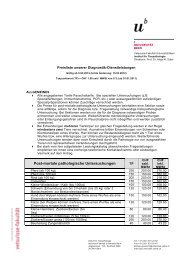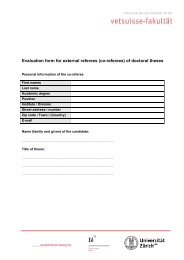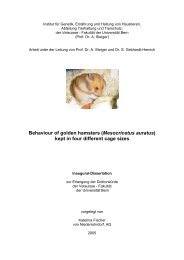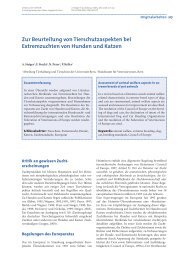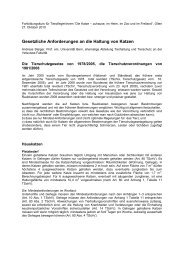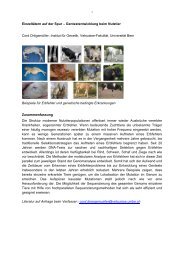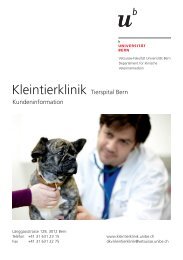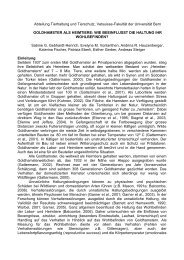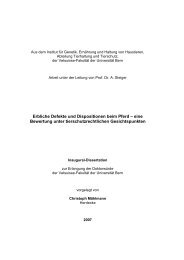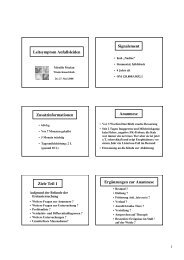86 Fischer et alFigure 1Timetable <strong>of</strong> the experiment. The stresstreatment was conducted dur<strong>in</strong>g theweeks 11 and 12.husbandry rout<strong>in</strong>e stressors and to draw conclusions abouttheir welfare. <strong>Behaviour</strong> can be a good <strong>in</strong>dicator for thestate <strong>of</strong> welfare <strong>in</strong> animals (Mason 1991; Mason & Mendl1993; but see Mason & Latham 2004). The welfare <strong>of</strong>captive <strong>hamsters</strong> can be assessed by measur<strong>in</strong>g thefrequency and duration <strong>of</strong> wire-gnaw<strong>in</strong>g. Wire-gnaw<strong>in</strong>g <strong>in</strong>mice seems to <strong>in</strong>dicate the <strong>in</strong>tention <strong>of</strong> break<strong>in</strong>g-out <strong>of</strong> thecage to explore the environment (Würbel et al 1998a, b;Nevison et al 1999). It is common <strong>in</strong> <strong>golden</strong> <strong>hamsters</strong> <strong>kept</strong><strong>in</strong> captivity (Gebhardt-Henrich et al 2005). The more ahamster performs this, the more welfare could be compromised.Physiological measurements, such as adrenalhormones and adrenal weight can also <strong>in</strong>dicate stress andwelfare <strong>of</strong> the <strong>golden</strong> hamster. Dur<strong>in</strong>g chronic stress,adrenal weight is <strong>in</strong>creased due to <strong>in</strong>creased hormonalproduction and can, therefore, be a helpful physiologicalparameter <strong>of</strong> stress measurement (Zimmer & Gattermann1986). S<strong>in</strong>ce the study focused especially on pet <strong>hamsters</strong>,cage sizes considerably larger than common laboratorycages were used. Areas <strong>of</strong> cages used <strong>in</strong> this study rangedfrom 1,800 cm 2 to 10,000 cm 2 . The area <strong>of</strong> the smallest cagewas chosen because it provided the m<strong>in</strong>imum for <strong>golden</strong><strong>hamsters</strong> <strong>in</strong> the Swiss pet shop guidel<strong>in</strong>es. An area <strong>of</strong>2,500 cm 2 is a common size for a hamster cage. The SwissAnimal Protection Society (STS) demands a m<strong>in</strong>imum area<strong>of</strong> 5,000 cm 2 and they recommend a cage <strong>of</strong> more than10,000 cm 2 (Lerch-Leemann 2002). In order to reducevariation due to sex, only one sex (female) <strong>hamsters</strong>were used.Materials and methodsAnimals and hous<strong>in</strong>g conditionsThe sixty female <strong>golden</strong> <strong>hamsters</strong> used for this study wereprogeny <strong>of</strong> the stra<strong>in</strong> Crl: LVG (SYR) from Charles River,Germany. Dur<strong>in</strong>g one year the sixty <strong>hamsters</strong> were bred <strong>in</strong>three series <strong>of</strong> 20 <strong>hamsters</strong> each. We used 17 dams and9 sires. The age difference <strong>of</strong> <strong>hamsters</strong> <strong>in</strong> one series wasmostly <strong>four</strong> days, up to a maximum <strong>of</strong> seven. A photoperiod<strong>of</strong> 12 h light, 12 h dark, dawn at 1300h was ma<strong>in</strong>ta<strong>in</strong>ed.Room temperature was 21 ± 2°C, relative humidity was notregulated, but ranged from 25 to 59%. Hamsters used <strong>in</strong> thisstudy were born and raised <strong>in</strong> cages with a wire top and adark blue opaque plastic dishpan as the bottom(95 × 57 × 45 cm; length × breadth × height) without arunn<strong>in</strong>g-wheel. Between 24 and 30 days <strong>of</strong> age, they wereplaced s<strong>in</strong>gly <strong>in</strong>to <strong>four</strong> differently sized cages: Size 1 was32 × 57 × 45 cm (length × breadth × height), ie 1,800 cm 2 ;size 2, 44 × 57 × 45 cm ie 2,500 cm 2 ; size 3, 95 × 57 × 45 cmie 5,000 cm 2 and size 4, 105 × 95 × 45 cm ie 10,000 cm 2 . Allcages were furnished with a wooden shelter(20 × 14 × 14 cm) with one entrance <strong>in</strong> front, litter (15 cmdeep wood shav<strong>in</strong>gs), hay, paper-towels, cardboard tubes,twigs, a sand-bath (diameter: 16 cm, ch<strong>in</strong>chilla sand) and arunn<strong>in</strong>g-wheel (diameter: 30 cm, width <strong>of</strong> perforated metalplate runn<strong>in</strong>g surface: 10 cm). Commercial pet hamster food(Witte Molen®, NL-Meeuwen) and water were <strong>of</strong>feredad libitum. This diet was supplemented by dry cat food andvitam<strong>in</strong> and m<strong>in</strong>eral supplements (Marienfelde Vitakalk). Inaddition, fresh fruits and vegetables were <strong>of</strong>fered daily.Litter was never changed completely. Only the dirty parts <strong>of</strong>the litter were replaced when necessary. Due to spacerestrictions, the experiments were performed <strong>in</strong> three series.Five cages <strong>of</strong> each size were used simultaneously. In each<strong>of</strong> the three series, 20 <strong>hamsters</strong> were distributed s<strong>in</strong>gly <strong>in</strong>the 20 cages. If possible, <strong>hamsters</strong> <strong>of</strong> one litter were placedrandomly <strong>in</strong>to all sizes, but the distribution was balancedaccord<strong>in</strong>g to their body mass <strong>in</strong> cages <strong>of</strong> <strong>four</strong> different sizes.The experiment was approved by the Cantonal Veter<strong>in</strong>aryOffice, Herrengasse 1, CH-3011, Berne, Switzerland.Procedure and measurementsProcedureIn week 0, at wean<strong>in</strong>g, the <strong>hamsters</strong> were approximately4 weeks <strong>of</strong> age. Dur<strong>in</strong>g the experiment they were weighedand videotaped on several occasions (Figure 1).In weeks 11 and 12 each hamster was stressed on twoconsecutive days. At 17 weeks <strong>of</strong> age, the <strong>hamsters</strong> weredecapitated after is<strong>of</strong>lurane-anaesthesia. The stresstreatment started with strongly shak<strong>in</strong>g the cage <strong>in</strong> a mannerthat the hamster was certa<strong>in</strong>ly woken up and probably upset.The animal was then chased briefly and handled for about30 – 60 seconds once caught. Handl<strong>in</strong>g consisted <strong>of</strong> pett<strong>in</strong>gand hold<strong>in</strong>g the hamster which was always keen to retreat.After handl<strong>in</strong>g, the hamster was placed <strong>in</strong>to a smallcardboard box for 30 m<strong>in</strong> and exposed to loud music forthree to five m<strong>in</strong>utes before be<strong>in</strong>g returned to its cage.© 2007 Universities Federation for Animal Welfare
Cage size for <strong>hamsters</strong> 87Figure 2Duration <strong>of</strong> behaviours <strong>in</strong> percent <strong>of</strong> total duration <strong>in</strong> the different cage sizes: a) wheel-runn<strong>in</strong>g, b) rest<strong>in</strong>g, c) rear<strong>in</strong>g, d) groom<strong>in</strong>g, e)wire-gnaw<strong>in</strong>g, f) feed<strong>in</strong>g, g) runn<strong>in</strong>g, h) gnaw<strong>in</strong>g, i) climb<strong>in</strong>g, j) digg<strong>in</strong>g, k) dr<strong>in</strong>k<strong>in</strong>g.Additionally, on the first day <strong>of</strong> stress, half <strong>of</strong> the litter waschanged while, on the second day, a confrontation withanother hamster was <strong>in</strong>stigated. At the end <strong>of</strong> the experiment,immediately prior to euthanasia, the anaesthetisedanimal was stretched out on a ruler and body length (snoutto tip <strong>of</strong> tail) was measured. The body condition <strong>of</strong> thehamster was calculated as bodyweight relative to bodylength (bodyweight at week 13/length 3 ); as a degree <strong>of</strong>adiposis. Blood was collected and analysed for corticosterone,cortisol and ACTH. After dissection the adrenalglands, heart, and spleen were weighed and the gastricmucosa was exam<strong>in</strong>ed for ulcers. As a precaution, all bra<strong>in</strong>swere exam<strong>in</strong>ed for hydrocephalus <strong>in</strong>ternus, as the conditionwas prevalent <strong>in</strong> the colony, although without anydetectable behavioural changes (Edwards et al 2006).Runn<strong>in</strong>g-wheel activityRevolutions <strong>of</strong> runn<strong>in</strong>g-wheels were constantly registeredby the Chronobiology Kit (Stanford S<strong>of</strong>tware Systems).For the analysis <strong>of</strong> the runn<strong>in</strong>g-wheel activity we used themedian <strong>of</strong> the daily revolutions until week 10, prior tostress<strong>in</strong>g the <strong>hamsters</strong>. For the analysis <strong>of</strong> the effects <strong>of</strong> mildstressors, the mean number <strong>of</strong> revolutions dur<strong>in</strong>g the 2 daysthese stressors were applied, as described above, as well as2 days before and after application, were compared.<strong>Behaviour</strong>The behaviour <strong>of</strong> the <strong>hamsters</strong> was recorded 3 times <strong>in</strong>weeks 3, 6 and 10 by us<strong>in</strong>g a light sensitive camera(Ikegami ICD-47E) and a video recorder (Panasonic AG-6730) from 1430 until 1730h. The highest level <strong>of</strong> activityoccurred dur<strong>in</strong>g this period (Fischer personal observation2004). A total <strong>of</strong> thirty m<strong>in</strong>utes <strong>of</strong> active behaviour perrecord<strong>in</strong>g, dur<strong>in</strong>g which period the hamster stayed outsidethe shelter, ie the subject was awake and clearly visible, wasanalysed us<strong>in</strong>g the Observer Version 5.0 (Noldus). Thethirty m<strong>in</strong>utes were split <strong>in</strong>to six × five-m<strong>in</strong>ute observation<strong>in</strong>tervals. If possible, the <strong>in</strong>tervals were equally spaced overthe three recorded hours. If observation <strong>in</strong>tervals could notbe equally spaced over the 3 hours <strong>of</strong> record<strong>in</strong>g, a total <strong>of</strong>thirty m<strong>in</strong>utes, ie 6 <strong>in</strong>tervals <strong>of</strong> the time when the <strong>hamsters</strong>were visible on the tape would, nonetheless, still beanalysed. In some cases 4% (7 <strong>hamsters</strong>, each with 1 observation)<strong>of</strong> <strong>hamsters</strong> were active for less than 30 m<strong>in</strong>utesdur<strong>in</strong>g 3 hours <strong>of</strong> record<strong>in</strong>g, therefore their observationalAnimal Welfare 2007, 16: 85-93


